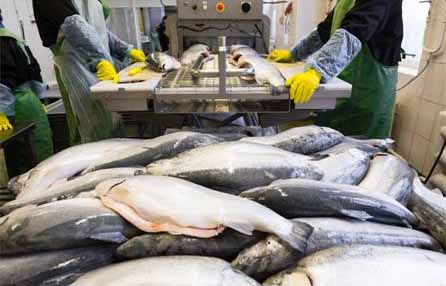Paralleling Generators for Alaska Seafood Plant
Four generators connected in parallel supply power to seafood processing plant in Alaska.
 Remote Seafood Processing Plants
Remote Seafood Processing Plants
An ideal location for a seafood processing plant is in a harbor with access to shipping lanes that are convenient for both import and export of product. The best location for importing, processing, and exporting seafood can result in production challenges. Some of these challenges are:
- Utility supplied power is not available
- Natural gas supply is not available
- Fresh water supply is from well or desalination plant
- Extreme weather conditions
- Difficult to access property - water or air access only
- Battery powered communications (batteries require charging)
A seafood processing plant schedules production around various seasons. Larger processing plants can operate through multiple seasons. When a production crew arrives on site, they are typically there for the extent of the season. Lodging and meals are generally part of the package. Production hours can range from 16 hours to 24 hour shifts.
The ability to have a dependable power supply allows the processing plant to overcome challenges. Electricity provides power for water pumps, production equipment, housing requirements and a host of additional services. This allows the processing plant to accept, process, and ship as much catch as rendered.
Powering Remote Locations
The most economical and practical solution is typically the use of a diesel generator. Water access is an easy transportation method for generator(s), fuel tank(s), generator accessories, and fuel.
Processing plants with a lower power requirement can use a two generator arrangement. One of the generators is used to supply power and one as a redundant backup. When the primary generator fails the secondary is automatically started. Secondary generators will assume the load during scheduled maintenance and repair.
Processing plants with large amounts of automated production equipment and higher power requirements can use multiple generators connected in parallel. This allows for more than one generator to be operated to share the load. As the load demand increases, generators can be put online to support the demand automatically. When the load decreases, generators are removed from the load and shutdown. They are available for operations load demands fluctuate and change.
Multiple Generator Configuration with Video
Multiple generator configurations can allow for performing maintenance without affecting the systems load handling capabilities. Recently, we sold four 500 kW generators to a seafood processing plant in Alaska. The customer required them for their remote island facility. For more details and to see the units being tested and ran in parallel prior to shipment be sure to watch the video.
Generator Source provided the controller setup, testing, and startup on-site, service and the paralleling capabilities for this multiple generator configuration. To set additonal details be sure to visit our
Seafood Processing and Packing Plants applicatin article for more details.
administrator
| 1/31/2018 2:03:07 PM
|
0 comments